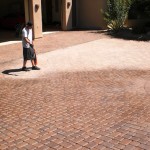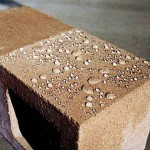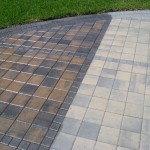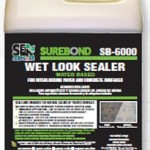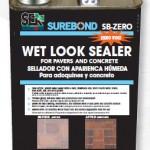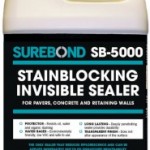
To Seal or Not to Seal?
After investing in a paver patio or driveway, customers often wonder whether they should seal it. We often recommend a joint stabilizing sealer, which is a liquid product that penetrates into the surface of not only the paver, but the sand in the joint as well. This style of sealer has added benefits to those provided by a traditional sealer.
Any sealer will make pavers resistant to stains from spilled material, oil, dirt, etc. Sealed pavers also resist UV rays which may help your pavers retain their natural color longer, though most pavers today are manufactured to resist UV rays. Sealers are available in different styles, from matte to semi-gloss to high-gloss sheen depending on the client’s taste. Many people prefer glossy pavers which can give your pavers a “wet look”, causing the natural color of the pavers to appear more vibrant. Typically, the darker the paver, the more pronounced the color will be after applying a glossy sealer. Joint stabilizing sealers have the additional benefit of preventing weeds from growing between paver joints. Because it soaks into and hardens joint sand, it also causes the sand to resist displacement from rain, wind, and insects.
Sealing pavers may not be for everyone. While there are many benefits to sealing pavers, it does add necessary maintenance to an otherwise low-maintenance system. Sealed pavers need to be resealed every 3-5 years if using a water-based sealer and 2-3 years if using an acrylic sealer. When resealing pavers, be sure to use the same paver sealer that was originally applied. Different sealers use different formulas, and a chemical reaction may occur if two types of sealers come into contact with each other. This generally creates a cloudy, white appearance. If you cannot remember what sealer was originally used, test the new sealer on a small area or strip the original sealer from the pavers before applying the new coat. If a client seals their pavers and decides it is unnecessary for any reason, the sealer can be stripped and the pavers can be left in their natural, unsealed state.
While we highly recommend that our clients seal their pavers to protect their investment, there are a few things to note when sealing pavers. Clients wishing to have sealed pavers should wait 1 year after installation to seal their pavers in order to allow the efflorescence to evaporate from the paving stones. Failure to do so may create a white, dusty-looking build-up of efflorescence on the surface of the paving stone over time. If applying a glossy sealer to paving stones, keep in mind that less porous stone will take a glossy finish more easily than a stone that is highly porous. This is due to the sealer absorbing into the stone. It is not recommended to use coating sealers on or around pool decks as they may make pavers slippery when wet.
Tips When Sealing Pavers
- Wait 1 year prior to sealing to ensure you do not trap efflorescence.
- Sweep, power wash, and pull weeds growing within paver joints prior to beginning the sealing process.
- Use a quality sealer to avoid discoloration and to increase the time between necessary reapplication. We highly recommend Surebond products.
- If utilizing a roll-on application as opposed to a spray-on application, use a sponge roller. Nap rollers are more likely to catch joint-sand. If a nap roller is all that is available, make sure the naps are shorter than 1/4 in.
- Wait 24 hours after applying the final coat before walking or driving over the newly sealed pavers.

